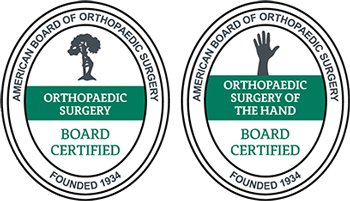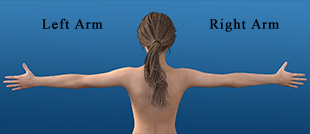What is the Difference Between a Mucoid Cyst and a Ganglion Cyst?
If you’ve recently developed a growth on your hand, you may be concerned about what it is. There are many different causes of growths on hands, two of which are ganglion cysts and mucoid cysts. The team at The Hand and Wrist Institute in Dallas has put together this guide to help you understand more about them.
Contents
What Are Ganglion Cysts and Mucoid Cysts?
Ganglion cysts are a type of benign growth that often occur on the hand near the wrist but can appear in many places. These cysts grow out of the tissue, such as tendons, around joints. Mucoid cysts are a sub-type of ganglion cyst that grow near finger or toe joints. These growths are filled with fluid, vary in size, and are attached by a stalk.
What are the Symptoms?

These cysts may cause mild symptoms or none at all. The most common symptom is an aesthetic change. Occasionally, they can cause more severe symptoms such as numbness or weakness. Depending on the location and the size of the cyst, some patients may experience mild-to-moderate pain. These more severe symptoms are typically caused by the cyst putting pressure on a nerve. The symptoms that you experience will factor into the treatment decision.
What Is the Diagnostic Process?
The most important aspect of diagnosing ganglion cysts is the physical examination. The physician will examine the hand, wrist, and growth. This will involve feeling the area of the growth for tenderness and firmness and assessing the ability of the hand and wrist to move. The physician will likely also shine a light through the growth. This is done to check its contents. If it’s a ganglion cyst, the light should pass through relatively easily because it will be filled with fluid.
The physician will also ask you questions about the growth and your medical history. Imaging, such as X-rays, may be performed. If the growth is a ganglion cyst, it won’t be visible on the produced images. However, this is done to rule out other possible diagnoses. These images will also help the physician to assess potentially associated osteoarthritis damage.
Another thing that the physician will be looking at throughout this assessment is the area of skin over the cyst. It will be important for them to check the thinness of the skin in this area. If the area is too thin, it may play a role in the treatment decision.
What Else Could It Be?
During the assessment, the physician will be looking to rule out a few other diagnoses. Some potential things with similar presentations are carpal boss, certain types of injuries, and bone tumors. The presentation and assessment for carpal boss and ganglion cysts are essentially the same. However, the treatment will be different depending on the diagnosis. For a carpal boss, the treatment is usually pain management through limited activity and non-steroidal anti-inflammatory drugs. Bone tumors will require more extensive testing and treatment with additional specialists.
What Causes These Cysts?
The exact cause of these types of cysts is not known. However, there is some evidence suggesting that they could be caused by connective tissue deterioration, underlying weaknesses in tendons, or previous injuries. Some factors make certain individuals more likely to develop these cysts. For example, ganglion cysts are more common for women than men. Additionally, individuals who have osteoarthritis and previous injuries are more likely to subsequently be diagnosed with a ganglion cyst.
What Is the Treatment?
The treatment for ganglion cysts and mucoid cysts varies. The physician will need to complete their full physical assessment and review all imaging to determine the best treatment course. They will also review your goals and symptoms. If you can accomplish everything that you need to with minimal pain or limitations, you may not require any intervention.
In fact, some cysts are so small and non-intrusive that they aren’t felt at all. In this case, they are usually found during other imaging and assessments. However, they will need to be watched over time but not immediately intervened with. If it is determined that the growth will just be observed, there are a few things you’ll need to monitor, such as the size and color of the cyst. You will also need to note if there is pain and if the pain or the size of the cyst changes.
Some people report that their cyst shrinks with rest and grows with increased activity. For this reason, it is recommended to try to limit activity if the growth is causing discomfort. A brace may be provided to help restrict movement.
If your cyst is causing more symptoms than just discomfort and it isn’t relieved by rest, you may be assessed for further intervention. The next interventions that would be considered typically are aspiration and surgery. There are advantages and risks with both of these, which will be discussed with you.
Aspiration
Of the possible interventions, this is the least invasive option. Aspiration involves draining the cyst. During this procedure, the area is numbed locally. Then the physician will insert a needle into the cyst and draw as much of the fluid out as possible. This method can provide relief and is associated with minimal complications. However, it also carries a high rate of recurrence due to the fact that it leaves the stalk intact. The cells taken during aspiration can also be tested to confirm the benign status of the growth.
Surgical Excision
In some cases, surgery may be needed or desired in order to relieve the symptoms associated with ganglion and mucoid cysts. If surgery is required, the surgeon will use anesthesia so that you don’t feel the process.
They will then make an incision and remove the cyst and the stalk that it is attached to. Removing the stalk is important for reducing the risk of recurrence. If the skin over the cyst is in good condition, the surgeon will simply suture it back. However, if the skin over the cyst is too thin, a graft may be necessary. Patients are typically able to go home the same day. You may need to follow up for post-operative care or physical therapy.
If you need surgery or an evaluation, our team of specialized physicians is here to help you. Give us a call today to schedule an assessment at one of our locations in the Dallas-Fort Worth metro area.
Image by Internet Archive Book Images is licensed with CC0 1.0

























